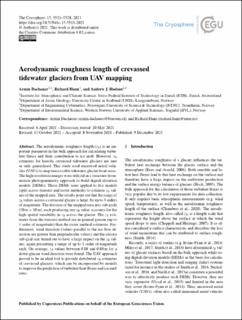Aerodynamic roughness length of crevassed tidewater glaciers from UAV mapping
Peer reviewed, Journal article
Published version
Permanent lenke
https://hdl.handle.net/11250/2983426Utgivelsesdato
2021Metadata
Vis full innførselSamlinger
- Import fra CRIStin [3604]
- Institutt for miljø- og naturvitskap [528]
Originalversjon
Dachauer, A., Hann, R., & Hodson, A. J. (2021). Aerodynamic roughness length of crevassed tidewater glaciers from UAV mapping. The Cryosphere, 15(12), 5513-5528. 10.5194/tc-15-5513-2021Sammendrag
The aerodynamic roughness length (z_0) is an important parameter in the bulk approach for calculating turbulent fluxes and their contribution to ice melt. However, z_0 estimates for heavily crevassed tidewater glaciers are rare or only generalised. This study used uncrewed aerial vehicles (UAVs) to map inaccessible tidewater glacier front areas. The high-resolution images were utilised in a structure-from-motion photogrammetry approach to build digital elevation models (DEMs). These DEMs were applied to five models (split across transect and raster methods) to estimate z_0 values of the mapped area. The results point out that the range of z_0 values across a crevassed glacier is large, by up to 3 orders of magnitude. The division of the mapped area into sub-grids (50 m × 50 m), each producing one z_0 value, accounts for the high spatial variability in z_0 across the glacier. The z_0 estimates from the transect method are in general greater (up to 1 order of magnitude) than the raster method estimates. Furthermore, wind direction (values parallel to the ice flow direction are greater than perpendicular values) and the chosen sub-grid size turned out to have a large impact on the z_0 values, again presenting a range of up to 1 order of magnitude each. On average, z_0 values between 0.08 and 0.88 m for a down-glacier wind direction were found. The UAV approach proved to be an ideal tool to provide distributed z_0 estimates of crevassed glaciers, which can be incorporated by models to improve the prediction of turbulent heat fluxes and ice melt rates.

